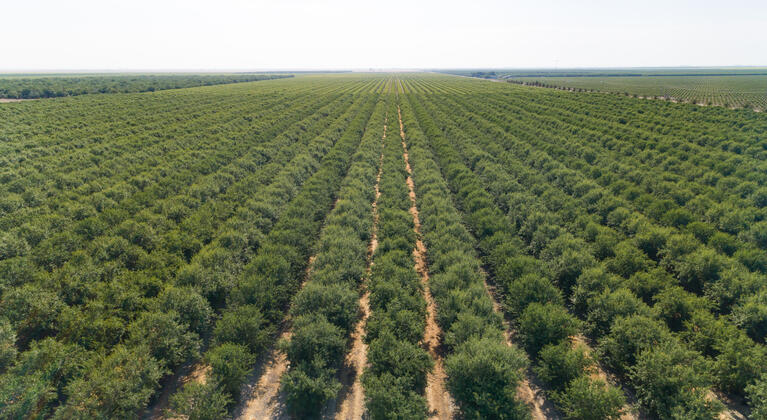Mitigate Effects of Environmental Stresses in Almonds with Calcium Nitrate
10 Reasons Why YaraLiva® CAN-17™ Calcium Nitrate Belongs in your Crop Program
Season after season, growers are faced with a variety of environmental stresses that are simply out of the industries' control. While nature and weather will take their course, with YaraLiva Calcium Nitrate, growers can give their plants and trees the strength needed to protect against environmental stresses such as heat, drought, salinity and excessive sodium.
Season Update: Help Your Trees Withstand Heat Stress
Temperatures are high and trees will be facing higher levels of stress through the remainder of the season due to heat and/or drought. Calcium plays a key role in decreasing this stress as part of the communication system in the plant by signaling water stress and triggering plant responses. Plant leaves transpire and the evaporation of water from the leaf cools the leaf. Leaves that are transpiring water are usually several degrees cooler than the air around them. Calcium, along with potassium, regulates the opening and closing of the guard cells around the stomates in leaves that regulate this transpiration process. Calcium immobility in the plant requires periodic supplementation to maintain adequate levels in the upper canopy. Plant tissues that lack sufficient Ca lose the ability to regulate the stomates and plants can become overheated. When plants overheat, the current crop suffers reductions in weight and stress on developing buds can compromise next year’s potential.
YaraLiva Calcium Nitrate Provides Fast Delivery of Critical Nutrients
Calcium is key throughout the life of the plant, right through to harvest. Roots need calcium for growth and a consistent supply is directly related to early fruit growth, healthy cell division, and the overall strength and health of fruits, vegetables and nut crops. Alongside potassium, nitrogen is the plant nutrient required in greatest quantities. Nitrogen is key for chlorophyll production and plays a major role in cell division, growth of new tissues and root system development.
The preferred form of nitrogen for plant uptake is nitrate, and plants can be susceptible to ammonium-nitrogen toxicity especially in cool wet soils. Higher plants, including many fruit and vegetable species, are especially sensitive to ammonium. Nitrogen sources in the form of urea or ammonium take time to convert to nitrate in the soil, leaving plants vulnerable. With fully soluble calcium and nitrate-nitrogen, YaraLiva products guarantee these critical nutrients are quickly and efficiently available to crops.
Low Carbon Footprint Solutions
Did you know YaraLiva products have a significantly low carbon footprint? Learn more.
Carbon Footprint From Fertilizing Almonds
Greenhouse gas emissions from almond farming arise from field activities such as using fuel for field operations and irrigation water pumping. Crop management operations and harvesting also contribute to the carbon footprint. The manufacturing and use of nitrogen fertilizer can also add a significant amount to this footprint.
Studies from the University of California show that high-frequency fertigation of almonds with YaraLiva calcium nitrate-based fertilizers have lower nitrous oxide emissions from the soil compared with UAN or other ammonium-based fertilizer. 1,2
To meet the recommended application of 68 pounds of nitrogen per 1,000 pounds of nuts, a switch to nitrate-based nutrition can benefit in additional ways too. Nitrate is the preferred source of nutrition for trees in the Rosacea plant family, including almonds. Additionally, nitrate fertilization avoids the undesirable soil acidification that inevitably occurs when fertilizing with ammonium or urea.
1 Schellenberg, D.L., Alsina, M.M., Muhammad, S., Stockert, C.M., Wolff, M.W., Sanden, B.L., Brown, P.H., Smart, D.R. Yield-scaled global warming potential from N2O emissions and CH4 oxidation for almond (Prunus dulcis) irrigated with nitrogen fertilizers on arid land. Agric. Ecosyst. Environ. 2012, 155, 7–15.
2 Wolff, M.W., Hopmans, J.W., Stockert, C.M., Burger, M., Sanden, B.L., Smart, D.R. Effects of drip fertigation frequency and N-source on soil N2O production in almonds. Agric. Ecosyst. Environ. 2016, 238, 67–77.









































































